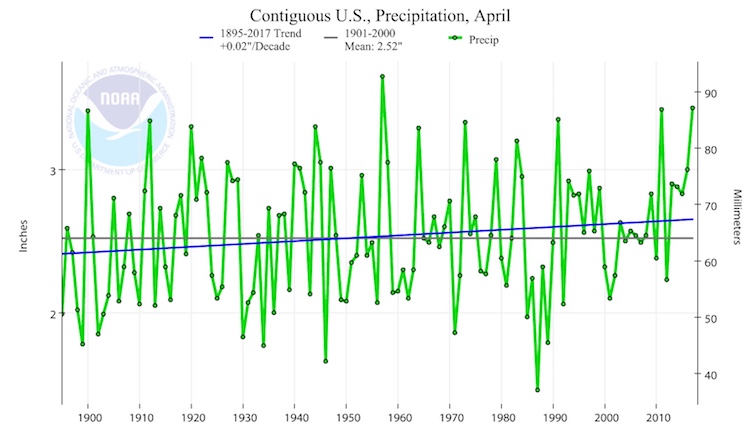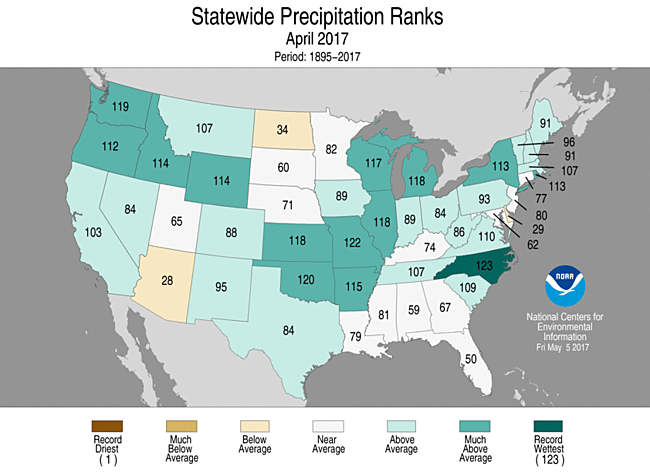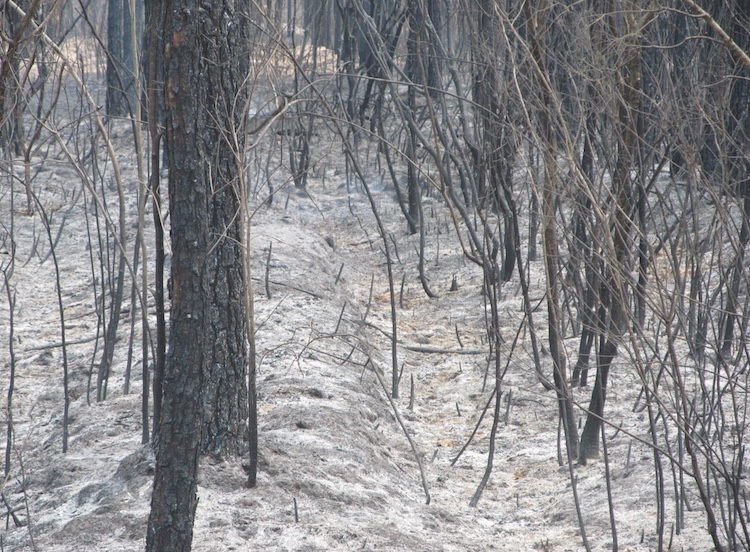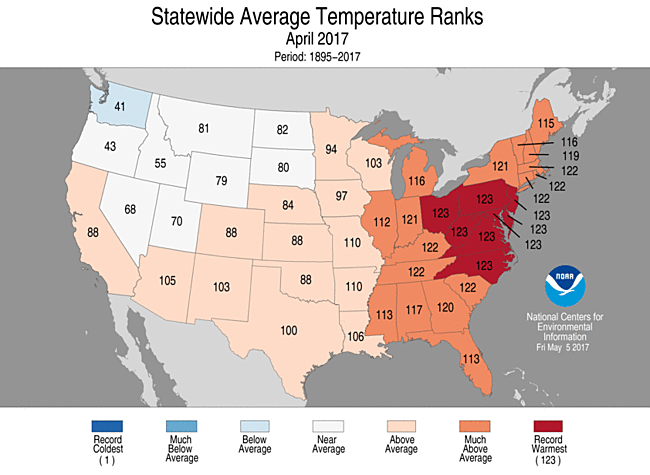| Above: A local business is submerged in floodwater along the Meramec River on May 4, 2017 in Fenton, Missouri. Towns along the Meramec and other rivers in Missouri and Arkansas dealt with significant flooding, including all-time record crests in some cases, after a wet April climaxed with an intense deluge on the weekend of April 29-30. Image credit: Michael B. Thomas/Getty Images. |
Last month was the second wettest April in U.S. records going back to 1895, according to the monthly summary released by NOAA’s National Centers for Environmental Information on Monday. Only 1957 had a wetter April, with a 3.65” average for the 48 contiguous U.S. states in April 1957 compared to 3.43” in April 2017.
 |
| Figure 1. Precipitation averaged for the contiguous U.S. for each April since official recordkeeping began in 1895. Although there is much year-to-year variability, April now averages about 8% wetter than it did a century ago. Image credit: NOAA/NCEI. |
Many of the places that trended wet through the winter continued to be soggy in April. This includes the Pacific Northwest, a belt from Oklahoma and Kansas to the Great Lakes, and parts of the mid-Atlantic (Figure 2).
North Carolina had its wettest April on record, while 11 other states made it into their top-ten-wettest-April lists. The extreme rainfall that pounded southern Missouri last week helped give the state its second-wettest April on record. Although two people died in flooding in North Carolina in late April, the state didn’t have any rainfall disasters on par with Missouri last month; however, as can be seen on a more fine-grained map (Figure 3), there was heavy precipitation over virtually all of NC, and that was enough to push the state’s April into record territory.
 |
| Figure 2. Statewide rankings for average precipitation during April 2017 as compared to each April since 1895. Darker shades of green indicate more moisture, with 1 denoting the driest April on record and 123 the wettest. Image credit: NOAA/NCEI. |
 |
| Figure 3. Same as Figure 2, except calculated for climate divisions within each state. Image credit: NOAA/NCEI. |
A drought of drought—but hardly anyone is complaining
One beneficial aspect of all this rain (and mountain snow) is that it’s pushed the extent of U.S. moisture shortage to its lowest levels of the 21st century. The weekly U.S. Drought Monitor issued on May 4 showed that just 4.21% of the entire nation (including Alaska, Hawaii, and Puerto Rico) was experiencing drought. That’s the lowest percentage since the monitor was established in 2000, breaking a record set just a week earlier, when the percentage was at 5.16%.
Despite this national-scale good news, some areas are hurting. This includes the western Big Island of Hawaii and the region near Washington, D.C., as well as parts of the Southeast. Especially parched right now is Florida, still in its dry season, where severe to extreme drought covered almost 40% of the state as of last week’s Drought Monitor. Burn bans are widespread across Florida, and more than 30,000 acres were engulfed in more than 100 active wildland fires as of Sunday.
 |
| Figure 4. This isn’t snow—it’s ash from the 38th Ave. Fire, which consumed thousands of acres in the Naples, FL, area in late April. Image credit: Florida Forest Service/Suwanee. |
A very warm year continues
From New Mexico across to Virginia and up to Ohio, a broad swath of 14 U.S. states across the southeast half of the country is having its warmest year on record. The contiguous U.S. as a whole ended up with the second-warmest January-to-April period on record, coming in just behind 2012 and just ahead of 2016.
 |
| Figure 5. Temperature averaged for the contiguous U.S. for each January-to-April period since official recordkeeping began in 1895 Image credit: NOAA/NCEI. |
 |
| Figure 6. State-by-state rankings for average temperature during April 2017 as compared to each April since 1895. Darker shades of red indicate more warmth, with 1 denoting the coolest April on record and 123 the warmest. Image credit: NOAA/NCEI. |
Nationwide, April came in as 11th warmest out of the 123 Aprils on record, but that value obscures some truly exceptional warmth. A block of eight states—Ohio, West Virginia, Pennsylvania, New Jersey, Delaware, Maryland, Virginia, and North Carolina—all experienced their warmest April on record. Every state east of the Mississippi had a top-ten warmest April except for Florida, Illinois, Mississippi, and Wisconsin. As was the case throughout the winter, the Pacific Northwest was the nation’s cool pocket in April, with temperatures running below average in Washington and Oregon.
Months that are both wet and warm typically see more impressive record-warm lows than record highs (a trend manifesting in U.S. climate as a whole, as catalogued by meteorologist Guy Walton). This was again the case in April. Only two states had their warmest average daily high for any April, but 15 states had their warmest average daily low.
For the year 2017 to date, the U.S. Records site on Monday shows that the U.S. has experienced a preliminary total of more than 14,000 local daily record highs but only about 2200 record lows—a ratio of more than 6 to 1. As noted by Walton, April marks the 29th consecutive month in which daily record highs outpaced record lows. In a non-changing climate, the ratio of record highs to record lows would balance out over time.



